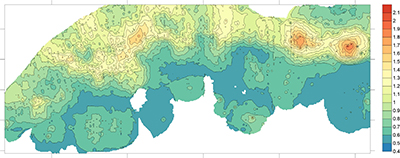Mineral exploration companies routinely undertake geochemical mapping at various stages of a project to define prospective areas for further investigation and followup work. A study recently completed at a chromite deposit demonstrates the effectiveness of using portable X-ray fluorescence (pXRF) for delineating platinoids and rare-earth elements (REEs). The exploration license covers an area of 1,220 ha and contains a sequence of ultramafic serpentinites, dunites, and peridotites that host the chromite mineralization. Two distinct ore types have been identified: 1) primary chromite ores and 2) late-stage veins containing arsenic, lead, and platinoids. Mineralization outcrops at the surface in a weathered, quaternary sequence that averages 0.5 m in width, and the surface is well exposed and devoid of vegetation. These deposits can also be clearly delineated using both magnetic and gravity geophysical survey techniques. |  |
Geochemical mapping was conducted for chromium (Cr), platinum (Pt), palladium (Pd), and rare-earth elements over a 27 ha project area using an Olympus Vanta™ M Series portable XRF analyzer. Mapping was completed prior to drilling and mining activities, and the results of this initial work suggest that it would be beneficial for a pXRF geochemical survey to be completed across the entire 1,220 ha site.
Work completed as part of this study included:
- A desktop literature review of chromite occurrences in the region
- Geochemical orientation study and survey design
- Calibration assessment of the pXRF analyzer to ensure it was fit for purpose
The geochemical orientation program was carried out element by element to define the required sample grid density, locations, and alignment. Standard geological plans/ maps, cross sections, block models, and projections were constructed at scales of 1:1000 and 1:10,000, in line with the statutory requirements for the region of interest.
The chromite deposits investigated in this study are quite complex and structurally controlled. Accordingly, they were summarized into:
- Medium- and small-sized deposits
- With lenticular or vein-like geometry
- Sometimes forming in nests and/or columns
- Scale varying between tens of meters to 300 meters in length, often broken up into small blocks by late-stage structures
The typical sampling density for this style of chromite deposit is in the range of 20 m to 50 m with 5% of the sample population comprising quality control samples (blanks, standards, and duplicates).
| Scale | Grid Density (m) | Samples | Control Samples | Total Samples |
| 1:2,000 | 20 × 20 | 729 | 37 | 766 |
| 1:5,000 | 50 × 20 | 297 | 15 | 290 |
| 1:5,000 | 50 × 50 | 121 | 7 | 128 |
Subsequently, the number of samples required to sample the entire 1,220 ha area was calculated in a similar way. A working scale of 1:10,000 was chosen, with a sampling grid density of 100 m × 50 m. The total number of samples was calculated as 2,684, including 5% quality control samples.
The client’s objective was to complete the geochemical maps of both the target area and entire exploration license in 10 days. This computed to 282 or 345 samples per day, depending on the sample density chosen. Considering the terrain to be covered, an average of 200–400 tests could be carried out in an 8-hour shift, which met the client’s requirements.
| Number of Days | Total Number of Samples | ||
| 3450 (766+2684) | 2974 (290+2684) | 2812 (128+2684) | |
| Samples Per Day | |||
| 10 | 345 | 297 | 282 |
|
Each result produced from the pXRF contains detailed multielement geochemistry and precision, sample meta-data, and 3D locations determined by the built-in GPS receiver. Location data is reported in a WGS-84 projection and can be exported rapidly, enabling the near-real-time creation of geochemical maps and fast data interpretation in the field. |  Figure 1. An example of a platinum deposit map. |
A detailed return on investment (ROI) analysis was conducted to calculate the value of using pXRF versus conventional laboratory methods, which endure long turnaround times and expensive sample handling and logistics involved with shipment to Moscow, Russia. For this work, the scale of 1:5000 was chosen, equating to 2974 samples collected over 10 days. In comparison, this is three times faster than the typical laboratory turnaround time and four times less expensive than using conventional lab methods. As such, it has been calculated that the purchase cost of an individual pXRF instrument will pay for itself 3-4 times over the life of this individual project.
In conclusion, this study demonstrates the significant value and acceleration in project timeframes that can be gained by using an Olympus Vanta™ pXRF instrument for rapid infield geochemical mapping. Throughout this project, it was demonstrated that results could be delivered in one-third of the timeframe, eliminating an extra month waiting, in addition to being delivered at a fraction of the cost.

